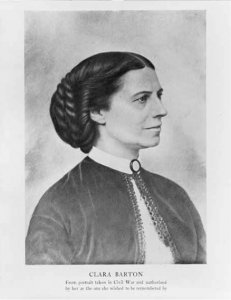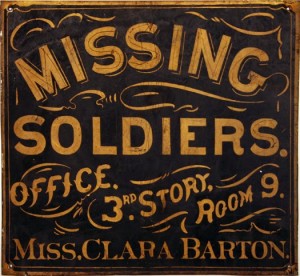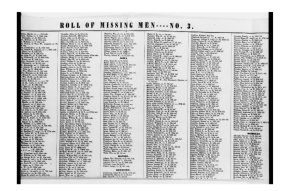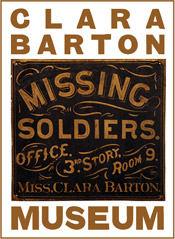Women’s History Wednesday: Clara Barton
Happy Women’s History Month! Throughout March, the Clara Barton Missing Soldiers Office Museum will highlight multiple notable women from the Civil War era. Join us for Women’s History Wednesdays!
It is already the last Wednesday in March! Our third and final post this month will discuss Clara Barton herself. If you have not done so already, we invite you to visit the Missing Soldiers Office to learn more about her life and legacy.
 |
| “From portrait taken in Civil War and authorized by her as the one she wished to be remembered by.” Image Source: Library of Congress, http://www.loc.gov/pictures/item/93513623/ |
Clarissa Harlowe Barton was born on December 25, 1821 in North Oxford, Massachusetts. Her eventful life spanned ninety years and her legacy of humanitarianism continues to be a source of inspiration. Within the public imagination, Miss Barton is most commonly remembered as a nurse. In reality, she worked originally as a schoolteacher and as a government employee; she actually possessed no formal nursing training. However, her proclivity towards caring for others was apparent from a young age. When Clara was a girl, her older brother David fell from a barn roof and she patiently nursed him back to health after his accident.
The aid that she later provided on the battlefield led to her more apt characterization as a medic and a first responder. On one occasion at the Battle of Antietam in September 1862, she was so close to the fighting that a bullet passed through the sleeve of her dress, striking and killing the man she was tending to. Ultimately, Clara Barton’s service during the Civil War earned her the nickname “Angel of the Battlefield.”
 |
| “Clara Barton monument at Antietam.” Image Source: National Park Service, http://www.nps.gov/anti/learn/historyculture/clarabarton2.htm |
After the war ended, Miss Barton launched The Office of Correspondence with Friends of the Missing Men of the United States Army, or Missing Soldiers Office. Her effort to discover the fate of thousands of men was facilitated by a young man named Dorence Atwater, who had been responsible for keeping a list of the dead at Andersonville Prison in Georgia. This invaluable list included approximately 13,000 names. While the Missing Soldiers Office was in operation, hundreds of letters arrived each day. Miss Barton and her clerks received approximately 63,000 of them over the course of four years. By 1869, they had identified 22,000 missing men, including the 13,000 from Andersonville. Needless to say, it was an impressive accomplishment.
 |
| Original tin sign, Missing Soldiers Office Image Source: http://www.civilwarmed.org/clara-barton-museum/visit-us/ |
 |
| Extensive lists of missing men were published to aid the mission of the Missing Soldiers Office. Image Source: Library of Congress, http://www.loc.gov/resource/mss11973.065_0008_0040/?sp=6 |
After the operations of the Missing Soldiers Office came to a close, Miss Barton spent time in Switzerland, where she witnessed the actions of the International Red Cross. Although many people know of Clara Barton as the founder of the American Red Cross, not as many are aware of her contribution of “The American Amendment,” a critical provision that transformed the Red Cross into an organization that was active not only in wartime, but also in peacetime.
In addition to her work on the battlefield and with the Red Cross, Clara Barton possessed progressive political beliefs and advocated for the rights of women and African Americans. She spent the latter portion of her life in Glen Echo, MD at a home that was also used as the headquarters for the American Red Cross. She remained active in humanitarian service and disaster relief throughout her old age.
 |
| Clara Barton, 1905 Image Source: National Park Service, http://www.nps.gov/media/photo/gallery.htm?id=25583136-1DD8-B71C-0783E5DDA7FD1ECE |
It is impossible for a brief blog post to do justice to the myriad accomplishments of Miss Barton’s incredible life. As an unmarried woman who lived in the Victorian era, she faced many obstacles, yet was able to assert her independence and provide aid to thousands of people. She left behind a legacy of kindness, compassion, and determination and exists today as an example of what incredible things an individual can accomplish.
Thank you for joining us for Women’s History Wednesdays!
Posted in: Uncategorized
